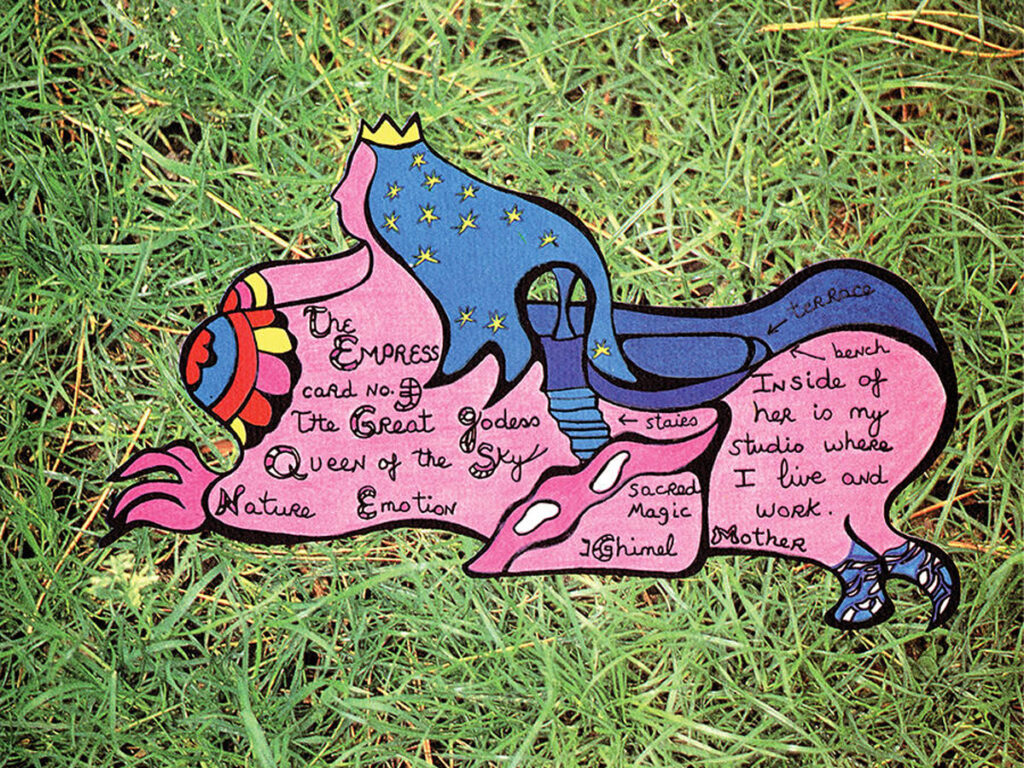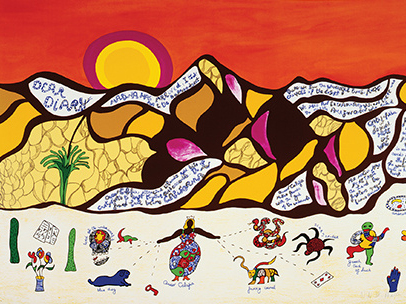Another WorldThe fantasias of Niki de Saint PhalleJillian Steinhauer, The Nation
reviews, 04/02/22

Excerpt from Tarot Cards in Sculpture, by Niki de Saint Phalle, published by Giuseppe Ponsio, Milan, 1985, and included in What Is Now Known Was Once Only Imagined: An (Auto)biography of Niki de Saint Phalle by Nicole Rudick, Siglio, 2022. Image courtesy of Niki Charitable Art Foundation.
Niki de Saint Phalle could be iconic even anonymously. In a 2014 interview, Gloria Steinem recalled passing the French American artist on the street in New York City “a long time ago” without knowing who she was. “She was walking on 57th Street and she had on one of those Australian raincoats…it was flowing out behind her,” Steinem said. “She had a cowboy hat and cowboy boots and no purse…. And I thought, ‘That is the first free woman I have ever seen in real life. I want to be just like her.’”
Despite Saint Phalle’s aristocratic lineage and moneyed upbringing, her freedom was hard-won. She fled a family shaped by strict class and gender norms and freighted with sexual abuse. She started a new family with a childhood acquaintance, only to suffer a nervous breakdown, which helped jump-start her artistic career. She became a successful woman in a male-dominated art world and the only female member of the one artistic group to which she belonged—the avant-garde Nouveaux Réalistes, many of whom drew on Marcel Duchamp and incorporated the everyday objects of life in order to better represent it in art. She struggled with relentless health problems and never had enough money to keep up with her creative ambitions.
These challenges are laid out in various forms in What Is Now Known Was Only Once Imagined, a new book about Saint Phalle by the writer Nicole Rudick. The unconventional volume is a selection of prose writings and graphic material by Saint Phalle—drawings, prints, and sketches—compiled to tell the story of her life and work. The subtitle dubs it “an (auto)biography,” which feels right in its hybridity: This is a highly subjective critical endeavor that’s almost frustratingly faithful to its source. Rudick has written a foreword and an afterword, but otherwise her hand is mostly invisible. In this way, the book posits that the best way to understand an artist is not by considering some combination of private and public encounters, but almost solely through their own work and words. “What could be closer to the artist’s voice than the artist’s own voice, closer to her sensibility than that produced by her own hand?” Rudick asks. Coming from a biographer, that question feels both radically and deceptively simple.
Like many artists, Saint Phalle used her work to animate and unpack the challenges and concerns of her life. “I WOULD SHOW EVERYTHING,” she wrote to her mother. “I would show fear, anger, laughter, tenderness in my work.” In fact, she so heavily shaped the public narrative about herself that “her life story…has become inextricable from her art, providing its overdetermined discursive context,” argues the art historian Amelia Jones in the catalog for a recent Saint Phalle exhibition co-organized by the Menil Collection in Houston and the Museum of Contemporary Art San Diego.
For Rudick, this is not a problem but a gift. “Her work is a diary, and she made it for all to see,” Rudick writes in her afterword. Building on this premise, What Is Now Known uses the work to reveal the process of its creation. Across disciplines—drawing, painting, sculpture, performance, printmaking, writing—Saint Phalle crafted a mythical world filled with symbolic angels and dragons, snakes and trees, brides, goddesses, and guns. She came to see her life in related terms, as a series of trials that were required to fulfill her ambition. “Today, I believe THESE DIFFICULTIES WERE NECESSARY,” she reflected concerning the Tarot Garden, a massive sculpture park that she worked on for more than two decades. “Every fairy tale contains a long quest before you find the treasure.” To some extent, we all practice this kind of narrativizing of the disparate events of our lives. For Saint Phalle, though, one gets the sense that her calling was the forging of her story as much as it was making art. Ultimately, her most feminist gesture may have been the creation of herself.
Originally published April 2, 2022. Continue reading at The Nation.
see also
✼ elsewhere:
“How do you know where the boundaries of a life are? How do you know where to stop? Or when something doesn’t apply?” —Nicole Rudick in conversation with Sam Stephenson at AIR/LIGHT
[...]
